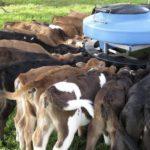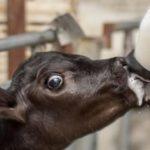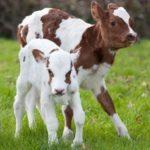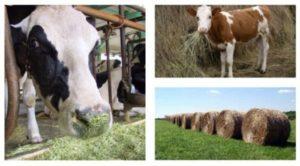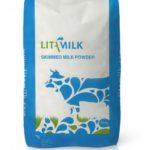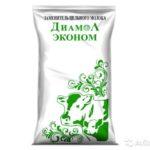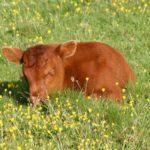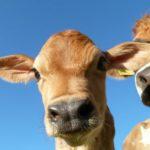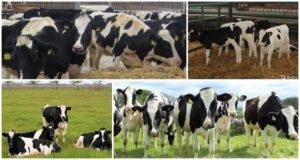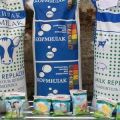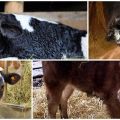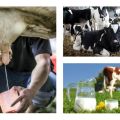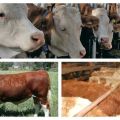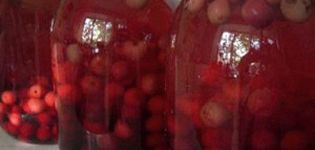How to breed milk powder per 1 liter of water and proportions for calves, the best milk replacer
Milk replacer - artificial mixtures on a protein basis, enriched with vitamins, microelements, fats, antibiotics, intended for feeding young cattle. The use of powdered milk for calves is a forced measure on livestock farms, used in case of problems with lactation in a cow or, if necessary, to save on feeding young animals. An artificial product is close to natural in composition, convenient for storage and transportation.
What is included in milk powder
Cattle breeders receive the main profit from the sale of dairy products. But almost 10% of the milk produced by cows is sucked out by calves. With the aim of production savings, in order to increase the percentage of products sold, farmers feed young cattle with a dry analogue. Substitutes are cheaper than cow's milk and contain all the substances necessary for the full development of calves.
At the heart of a quality analogue of whole cow's milk:
- whey remaining from the production of fermented milk products;
- return - separated skim milk;
- buttermilk is a low-fat cream that is separated during the production of butter.
The composition of milk powder may include additional components:
- lactose - milk sugar;
- casein - milk protein;
- lactoferrin - a multifunctional protein contained in the secretion of the mammary glands;
- other analogs of milk protein (plasma, wheat, soy, flax, egg white);
- vegetable or animal fat (palm and soybean oil, melted lard);
- immunoglobulins - blood plasma antibodies;
- organic and saturated fatty acids;
- vitamins (A, C, E, D, K, group B);
- mineral elements (potassium, calcium, iron, zinc, iodine, magnesium, selenium and others);
- growth stimulants;
- antibiotics;
- probiotics, lactic acid bacteria;
- yeast;
- Wheat flour;
- shit - crushed grain;
- premixes;
- blood;
- sapropel - lake algal silt.
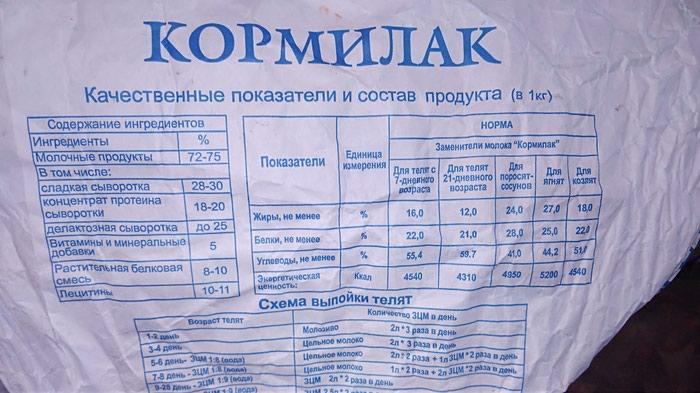
A specific list of additives is determined by the brand of the product and its intended use for a certain age category of young animals. The formula that determines the energy value of artificial milk is shown in the table in comparison with natural cow product.
| Components | WMS,% | Natural milk,% |
| proteins | 12-20 | 25 |
| fats | 12 | 4-6 |
| carbohydrates | 70-75 (before dissolution) | 36-38 |
| cellulose | 0,2 |
Benefit and harm
Powdered milk replacers are beneficial and convenient, therefore they are becoming more and more in demand.
The popularity of milk replacer is due to its beneficial properties:
- maintaining the health and immunity of calves;
- saturation of the growing body with the optimal amount of vitamins and minerals;
- increasing the survival rate of newborn offspring;
- excluding the possibility of infection of the calf with an infection (which is possible through the udder of a sick cow).
Damage to the health of the calf is possible in the following cases:
- if you feed the animal with an incorrectly prepared composition;
- if the shelf life of the product is not met (it is short);
- when blood enters the mixture of dubious quality (if the component is taken from the body of cattle infected with an infectious disease, then there is a high probability of killing all the young);
- if the composition contains cheap substances of plant origin (can negatively affect the work of the delicate digestive tract of the calf).
How to choose milk replacer
The dry product is made from whole milk by drying. The calf feeding substitute is fat-free and whole. Both types of milk are balanced in composition, have a list of components almost indistinguishable from a natural product, the difference is only in the concentration of nutrients, the content of additional substances.
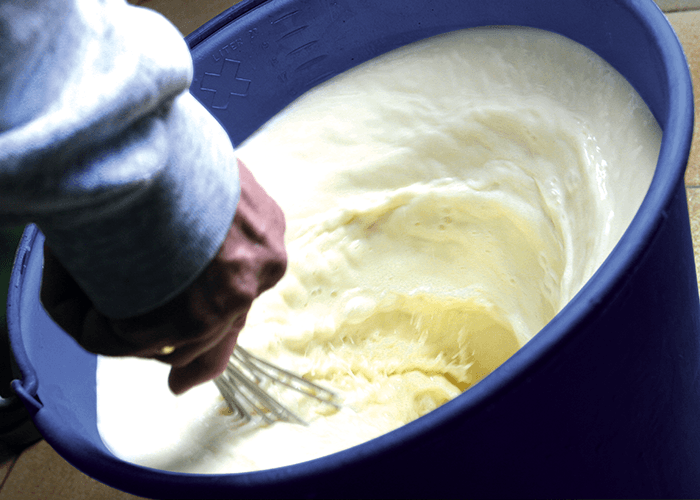
There are products on the market for feeding calves with different fat content. Dry mixes with 10, 15, 20% fat content are most in demand. In a quality product, proteins should prevail over fats. Protein-based milk replacer is divided into:
- buttermilk;
- buttermilk-whey;
- enriched (based on whey, vegetable protein - soy, wheat);
- fermented (based on fermented whey, acidophilic and propionic bacteria);
- fermented milk dry (based on acidophilic lactobacilli).
Milk replacements from modern manufacturers are divided into 3 categories by consistency:
- Dry - powder, diluted with water for drinking.
- Concentrated - similar to powder. But they are richer in nutrients, useful supplements. Therefore, a smaller portion of powder is required to obtain a solution.
- Liquid - ready-made substitutes based on skim whey.
On large farms, it is more convenient to use powdered preparations. The liquid mixture is stored less, it is impossible to purchase it for large livestock. It is not worth buying a cheap product of poor quality for the sake of economy. It probably contains soy flour, which can cause diarrhea and disruption of the digestive tract in a month-old calf.
In what proportions and how it is divorced
In order to properly dilute the product, the recommended dosage for calves of a certain age indicated in the table should be followed.
| Calf age, weeks | Solution concentration (ratio of powder to water mass) | Rate for one individual, liters |
| until 3 | 1:8 | 2,3 |
| 3-5 | 1:8 | 3 |
| 6-7 | 1:9 | 3 |
| 8-12 | 1:10 | 3 |
The indicated proportions are standard, but before diluting the powder, you should carefully read the manufacturer's recommendations on the package.
Instructions for use may differ from the standard, which is associated with the component composition of a particular milk powder.
For example, a high-fat product in a standard dosage will cause diarrhea in the calf, and nutritional deficiencies in milk may disrupt the microflora of the digestive tract.
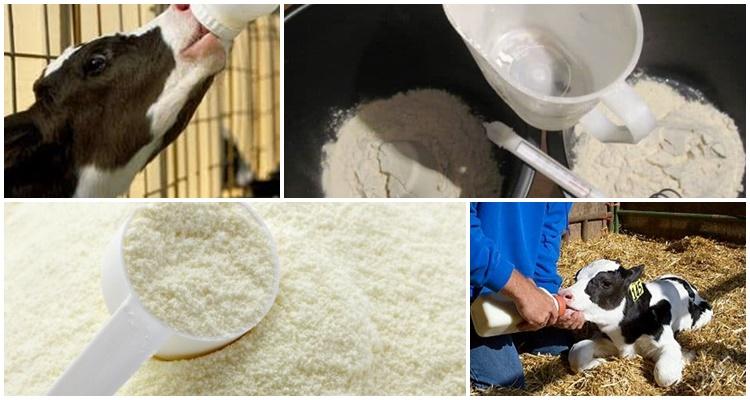
The preparation of milk powder is simple, it is necessary:
- Take fresh and clean water.
- Prepare the solution in glasses and bottles, previously disinfected with boiling water.
- To prepare reverse, divide the water: heat 2/3 to about 50 ° C, leave 1/3 at room temperature.
- Dissolve the powder in heated water, stir until smooth.
- Pour the second part of water into the concentrate to obtain a solution with a temperature of 38-40 ° C.
- Serve the calf immediately after cooking.
Do not dilute the dry mixture in cold water and then heat it, otherwise the powder will stick together into lumps. It is unacceptable to overheat the liquid, otherwise the proteins included in the milk will coagulate.
Rules for using milk replacer for calves at home
If the cow after lambing cannot give colostrum, then the calf can be watered with milk replacer from the first days of life.As an addition to the diet, milk replacer can be used when the calf is at least 10 days old. Until this time, it is important for the calf to receive maternal colostrum, saturated with vitamins and amino acids - substances that form immunity.
The daily intake for a 2-week-old calf is 7 liters of milk (1 kg of dry product). From the age of one month, the daily portion becomes, respectively, 5 liters (750 g). The nutritional value of 1.1 kg of dry matter corresponds to 10 liters of cow's milk. When diluted, 110 g of powder is taken for each liter of water. There are 2 options for calf feeding: late (12 weeks) separation from the mother and early (5 weeks) separation. For late parting, the following drinking pattern is optimal:
- first week - 5 liters of maternal colostrum per day and the minimum dosage of the substitute;
- 2 week - 6 liters of milk and 7 liters of milk replacer;
- 5 week - minimum portion of milk, artificial product - 8 liters;
- 6 months - 6 liters of substitute;
- 12 months - 4 liters
Algorithm of watering for early separation:
- the first week - 3-6 liters of maternal colostrum per day, 6 liters of milk replacer;
- 2 week - 6 liters of milk and a substitute;
- from 3 to 8 weeks - the exclusion of milk from the diet, the portion of the substitute is unchanged;
- 3 months - exclusion of dairy products from the diet, the transition of the animal to adult nutrition.
During milk feeding, the calf eats 30-42 kg of milk powder.
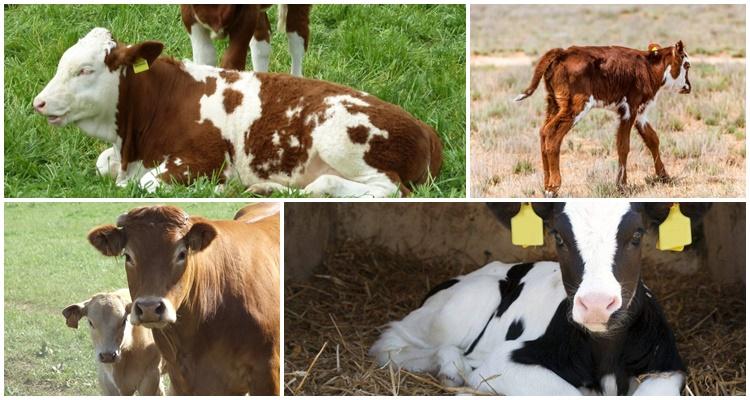
Popular brands
Cattle breeding is a developed and promising industry, therefore cow's milk substitutes are in demand on the market. Products manufactured by domestic and foreign companies differ in the main protein component, the presence of animal and herbal supplements, and cost. Leaders in the production of quality dry substitutes - Belgium, France, the Netherlands. Products manufactured in these countries are shown in the table.
| The product's name | Manufacturer country | Appointment |
| "Eurolac" | Netherlands | complete milk replacer |
| Optilak | Netherlands | for 3 week old calves |
| "Fokkamel" | Belgium | from birth to 3 months of life |
| "Kalvolak 16" | Netherlands | from birth to 2.5 months of age |
| "Milkrem Plus" | France | from 15 days of age |
| Joosten Milk | Netherlands | from the 4th day of life |
| "Prodlak" | Netherlands | from the 5th day of life |
Domestic companies also produce good products for calf feeding. Rating of the best Russian brands of milk powder:
- "Mologa" (JSC "Milk", Tver region).
- "Kormilak" (LLC "Tagris", Moscow).
- Kalvomilk (CJSC Mustang Feeding Technologies, Smolensk Region).
- "Milkovit" (LLC "Spectrum", St. Petersburg).
- Prolak 16 (Milk Standard LLC, Saratov).

The dry product "Prolak 16" should be diluted according to the standard proportion, and not according to the instructions indicated on the packaging bag, otherwise the calf may develop diarrhea. Products from foreign manufacturers are more expensive because they contain vitamins, minerals, premixes.
Errors in use
Most often, farmers, using dry mixes for feeding calves, make the following mistakes:
- For the sake of economy, they buy cheap products with vegetable proteins and fats, which are poorly digested in the digestive tract of calves.
- The temperature for preparing the milk solution is not observed (use a cooking thermometer).
- The dosage of the powder is violated (it is advisable to use a kitchen scale).
- They do not follow the drinking regime (30 minutes after feeding the calf must be given water for better assimilation of the concentrated product).
- Calves are watered from a bucket, not from a bottle with a nipple (when the calf does not suck, but licks, not enough saliva is released, the drink is poorly absorbed, diarrhea occurs).
- They do not follow the feeding regime (food is better absorbed when the young eat every day at the same hours).
- Give drink from unwashed dishes.
- Leave the unfinished milk mixture the next day (the product quickly deteriorates, pathogenic microorganisms begin to multiply in it).
There is no better nourishment for a calf than breast milk, but milk replacer becomes a lifesaver for a farmer with a large livestock, trying to sell as much dairy products as possible, to reduce its cost. The main thing is to buy high-quality analogs of milk from popular and proven manufacturers, so as not to face poisoning and indigestion in young animals.
